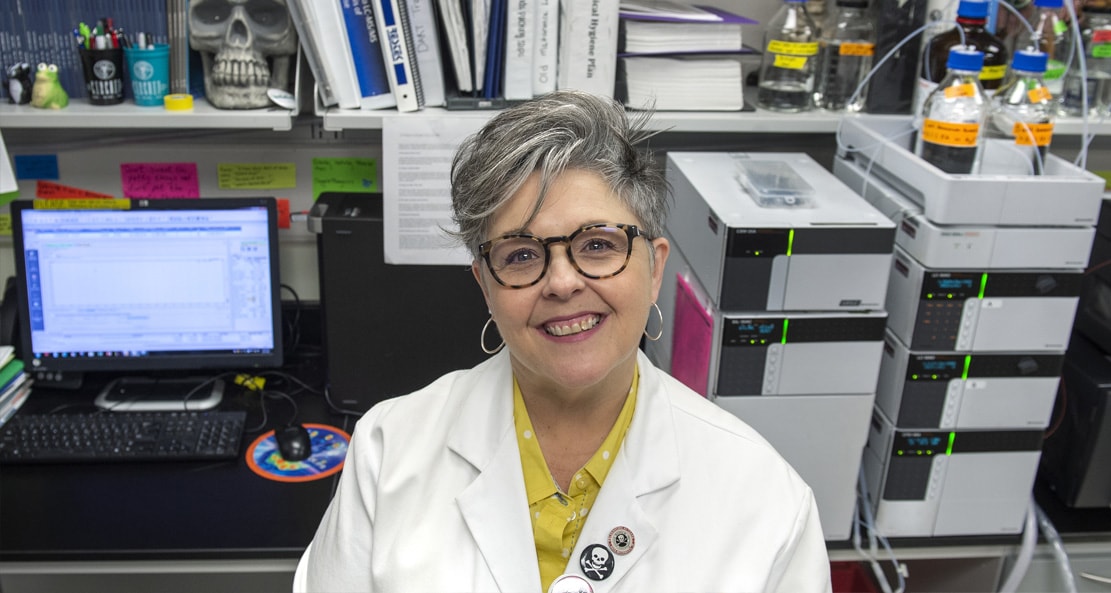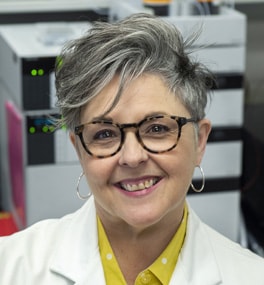Interview with Dr. Michelle Peace
Vol.10 Issue 2 / Interview 2“We share a core principle of being caretakers of each other and our earth that drives our collaborations and relationship.”
We interviewed Dr. Michelle Peace, Professor at Virginia Commonwealth University, on her research and projects in the Forensic Science program.
Thank you very much for spending some time for this interview. At first, could you outline the research and let us know what discovery and achievement have been made so far?
My pleasure – I appreciate the platform because I love to talk about what the research team has accomplished! We have a grant from the National Institute of Justice that supports evaluating the broad implications of vaping on public safety issues. The research has also supported public health education.
Early on, my team had to figure out the fundamentals of vaping – from the device construction to e-liquid formulations – to then postulate and monitor the marketplace for changes that allow for the inhalation of drugs other than nicotine. So, to the best of my knowledge, my team was the first to scholastically publish on the e-cig device evolution in a manuscript about an overdose from Blue Lotus using a dripping device (Poklis, J. L et al. 2017a).
We were also out front about the quality of nicotine e-liquid formulations (Poklis, J. L. et al. 2017b; Peace, M. R et al. 2018; Holt, A. K. et al. 2021a) in the United States, before there were any federal regulations. We’ve been vocal about the chemicals used in the formulations that are considered Generally Regarded As Safe (GRAS) to eat, but not to inhale (Holt, A. K., et al. 2021b). And, our most recent research is in evaluating the impact of vaping ethanol on roadside impairments evaluations, the breath tests, and on the formation of ethanol biomarkers. We have received dozens of emails and calls about people claiming they don’t drink but are failing ethanol-based drug tests. So, we are developing a unified method to evaluate 6 ethanol biomarkers in blood, urine, and oral fluid. We also know that people charged with DUI are claiming that they were vaping. They claim that the roadside impairment tests are skewed. According to our clinical study, this is likely not the case. The manuscript describing this study is under review.
We also do a lot of work in the cannabis space, developing methods for analyzing these new THC isomers and derivatives (Holt, A. K., et al. 2022a; Holt, A. K., et al. 2022b) that are poisoning thousands of people nationwide. And, we have several other projects that have significant public health implications, that I am particularly proud of, not the least of which is a study to evaluate whether or not physicians can predict if a newborn child is at risk of neonatal abstinence syndrome (Gesseck, A. M., et al. 2021).
So, we have a lot going on – and I have a great team who is passionate about these questions.

How are Shimadzu instruments helping you in your research?
My lab is predominantly a Shimadzu lab. We have 2 GCMSs,a GC-FID, and an LC-MS/MS. So, we use every one of them for different kinds of analyses. We have developed a really robust untargeted method on the GC-MSs, we do some quantitation work on the GC-MS, but really use the LC-MS/MS for that work because of its sensitivity and ease of sample prep. And, of course, we use the GC-FID for the volatiles analysis to identify ethanol and other solvents in products and in tissue. I’m really fortunate to have be able to explore all these issues in-house.
Could you tell us why you chose Shimadzu as your partner when you started this project?
Well, when I first started evaluating which instruments to purchase, I evaluated all the major manufacturers. We all know there are pros and cons to each platform, but I needed a relationship. And, while this may seem strange, a corporate philosophy and code of ethics mean something to me. When I learned that the corporate mission was embedded all the way to their employee evaluations, this felt important in helping me do what I needed to do in my personal mission to support public safety and health. When I started working with Shimadzu, I really felt like they were approaching my needs like a partner would. And, they worked hard with me to get the necessary functionality that enabled me to dig deeper while not poking giant holes in my very shallow pockets, for which I am deeply grateful. Admittedly, my lab operates fairly independently, so, when I need some help and ask, I really need it and there’s usually a multi-faceted tactic to get me online again or help me in developing a method. I also have a lot of student-researchers and they call for a lot of help – and I always appreciate that my students are always taken care of – that the service at Shimadzu is done in a teaching spirit.
not poking giant holes in my very shallow pockets, for which I am deeply grateful. Admittedly, my lab operates fairly independently, so, when I need some help and ask, I really need it and there’s usually a multi-faceted tactic to get me online again or help me in developing a method. I also have a lot of student-researchers and they call for a lot of help – and I always appreciate that my students are always taken care of – that the service at Shimadzu is done in a teaching spirit.
This is not to say that the instruments are not great. We have been very successful is leveraging the Shimadzu technology to make major strides in discoveries and there are definitely Shimadzu tools that I know exist and I say “wow, if only a had some cash…” For instance, the effort to minimize contamination on the front end of an LC-MS/MS is such a critical feature, and the fast switching between positive and negative ion modes is known to reduce run times. These are important considerations whether you are working in a research lab or a production lab.
Could you share your partnership between you and Shimadzu?
Well, what I appreciate are the relationships. Frankly, I feel like I’m pretty small potatoes – meaning, I’m not buying a new instrument every 2-3 years. BUT, they treat me and my students and my research questions like we’ve got $5M budget every year. When I think a widget on an

instrument could be better, they take that into considation – they listen to my team and ask questions. When I have an issue, they unpack the problem and call in others if necessary. We’ve asked some crazy questions and requested things that I thought were not workable – and they’ve figured that out. That’s a great collaborator.
It was significant to know what you think of us and our collaboration.We will strive to meet your expectation more than ever.Thank you very much.
Related publications using Shimadzu instruments
Poklis, J. L., Mulder, H. A., Halquist, M. S., Wolf, C. E., Poklis,A., & Peace, M. R. (2017a). The Blue Lotus Flower (Nymphea caerulea) Resin Used in a New Type of Electronic Cigarette, the Re-Buildable Dripping Atomizer.
Journal of psychoactive drugs, 49(3), 175–181.
Poklis, J. L., Wolf, C. E., 2nd, & Peace, M. R. (2017b).
Ethanol concentration in 56 refillable electronic cigarettes liquid formulations determined by headspace gas chromatography with flame ionization detector (HSGC-FID). Drug testing and analysis, 9(10), 1637–1640.
Peace, M. R., Mulder, H. A., Baird, T. R., Butler, K. E.,Friedrich, A. K., Stone, J. W., Turner, J. B. M., Poklis, A., &Poklis, J. L. (2018). Evaluation of Nicotine and the Components of e-Liquids Generated from e-Cigarette Aerosols. Journal of analytical toxicology, 42(8), 537–543.
Gesseck, A. M., Peace, M. R., Nanco, C. R., Wolf, C. E.,Hendricks-Muñoz, K. D., Xu, J., & Poklis, J. L. (2021).
Neonatal Exposure to Tramadol through Mother’s Breast Milk. Journal of analytical toxicology, 45(8), 840–846.
Holt, A. K., Poklis, J. L., Cobb, C. O., & Peace, M. R. (2021a).
Identification of Gamma-Butyrolactone in JUUL Liquids.
Journal of analytical toxicology, 45(8), 892–900.
Holt, A. K., Poklis, J. L., & Peace, M. R. (2021b). A Retrospective Analysis of Chemical onstituents in Regulated and Unregulated E-Cigarette Liquids. Frontiers in chemistry, 9, 752342.
Holt, A. K., Karin, K. N., Butler, S. N., Ferreira, A. R.,Krotulski, A. J., Poklis, J. L., & Peace, M. R. (2022a).
Cannabinoid-based vaping products and supplement formulations reported by consumers to precipitate adverse effects. Drug testing and analysis, 10.1002/dta.3253. Advance online publication.
Holt, A. K., Poklis, J. L., & Peace, M. R. (2022b). Δ8-THC,THC-O Acetates and CBD-di-O Acetate: Emerging Synthetic Cannabinoids Found in Commercially Sold Plant Material and Gummy Edibles. Journal of analytical toxicology, 46(8), 940–948.

Dr. Peace is a Professor for the FEPACaccredited Department of Forensic Science at VCU and is one of the founding faculty for the Department. She served as Associate Chair and Chair for nearly a decade. Dr. Peace has been funded by the National Institute of Justice since 2014 to study the efficacy of electronic cigarettes, particularly as they pertain to substance use and abuse. Dr. Peace has testified to the Food and Drug Administration regarding issues of quality assurance, public health, and public safety with the emerging cannabis industry. She has been featured in the New York Times,Consumer Reports, and AARP. The American Chemical Society and Discover Magazine recognized her research contributions in 2018 and 2019 as addressing some of the most salient and vexing issues in the nation.
